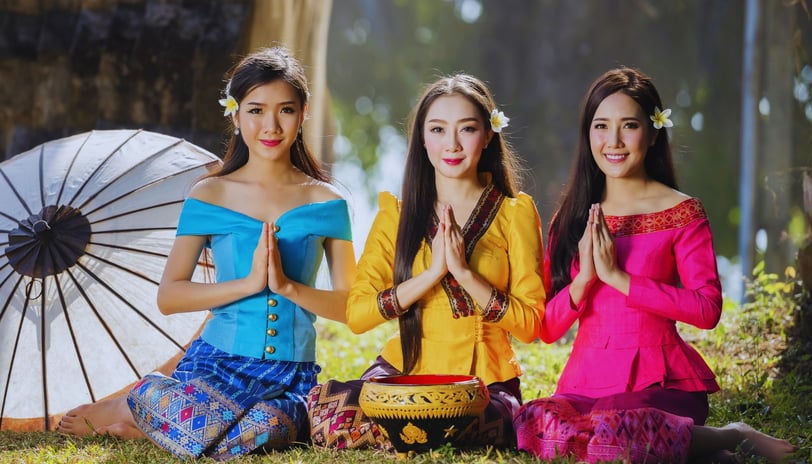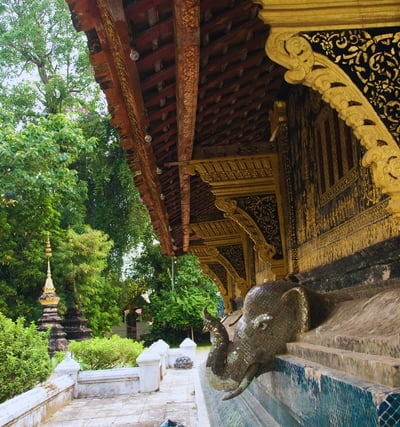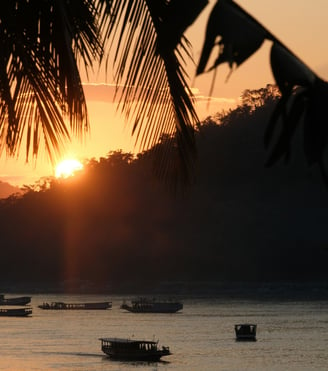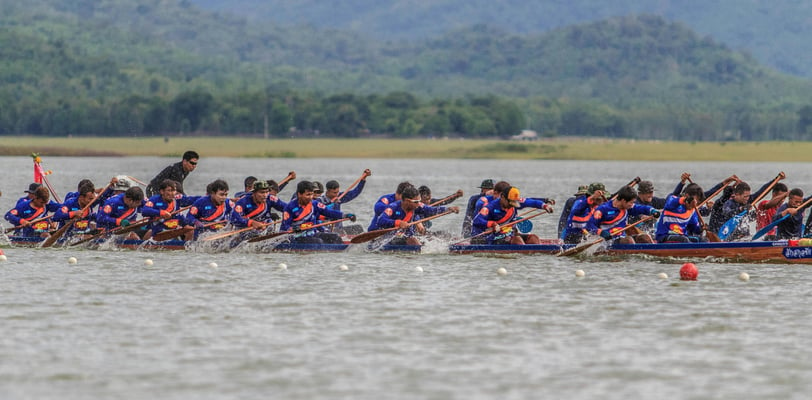Luang Prabang 2025: Timeless Temples, Artisan Legacies, and River Whispers


A city where saffron mornings meet riverlight afternoons, and silence carries centuries of memory.
Introduction: Where Rivers Shape Stories
Luang Prabang, Laos’ cultural jewel, is not a place that hurries. It rests gently at the meeting of the Mekong and Nam Khan rivers, where mornings begin with saffron-robed monks and evenings end in the hush of drifting boats. A UNESCO World Heritage site, the city is celebrated for its ancient temples, river rhythms, and artisan legacy.
In 2025, Luang Prabang continues to evolve—not through haste, but through quiet intention. Its spiritual heritage intertwines with sustainability, and its stories wait not to be captured, but to be heard.


Sacred Temples: The Timeless Soul of Luang Prabang
If Luang Prabang has a soul, it can be found in the hush of temple courtyards, in the rhythmic chant of monks at dawn, and in the footsteps left by centuries of seekers. The city is home to over thirty ancient temples, each a testament to its Buddhist devotion and architectural grace.
Wat Xieng Thong
The crown jewel of Lao architecture, this riverside temple gleams with golden reliefs and a tree-of-life mosaic that catches the light just before dusk. It remains a symbol of Luang Prabang’s enduring artistry and quiet power.
Morning Alms-Giving Ceremony
At first light, monks walk barefoot through the city streets as locals and travelers kneel with offerings. It’s not a performance—it’s a rhythm, an unbroken gesture of humility and connection.
Wat Mai Suwannaphumaham
Gilded and gentle, this temple near the Royal Palace glows with harmony between art and nature, its eaves catching falling leaves like blessings.
In 2025, these sacred spaces are not only preserved—they are lived in, prayed in, and protected by community-led conservation programs that honor both tradition and time.


Cultural Rhythms: Festivals and Artisan Legacies
Luang Prabang is not loud in its celebration, but it is rich in ritual. The city’s calendar moves in rhythm with its rivers and people, offering travelers glimpses into centuries-old ceremonies still practiced today. Artisan crafts remain the city’s living memory—markets brim with handwoven silks, hammered silver, and woodcarvings that echo mountain villages. In 2025, more artisan cooperatives open their doors to visitors—inviting not just admiration, but participation.
Traditional festivals are not merely events—they are expressions of spiritual, seasonal, and communal life. Below are the main cultural highlights travelers can experience throughout the year.
Sunset Cruises
Small wooden boats glide gently past jungle banks and golden stupas, offering quiet moments of reflection as the sun slips behind misted hills. Sustainable operators now lead these journeys with care for both ecology and culture.
The Bamboo Bridges
Handwoven and rebuilt each dry season, these ephemeral bridges connect more than riverbanks—they link daily life to ingenuity and resilience.
Floating Markets
Morning floats bring together villagers with produce, textiles, and stories—reminders that the river is still a marketplace, still a meeting place, still a source of life.
The River’s Memory: Stories from the Mekong
The rivers do not simply flow through Luang Prabang—they shape its breath, its pace, and its pulse. To understand the city is to follow the water.


Preservation and Sustainable Growth: A Future Rooted in Tradition
Preservation in Luang Prabang is not about resisting change—but guiding it gently, like steering a boat along a familiar bend. In 2025, the city embraces a model of tourism that uplifts its soul rather than selling it.
Programs to reduce single-use plastics and promote locally owned eco-lodges are reshaping the visitor experience.
Community-driven limits on tourist volume help protect heritage sites without isolating them.
Artisan training centers ensure that traditional crafts don’t fade—they evolve with new generations.
These aren’t just policies—they are ways of honoring what makes Luang Prabang different: its pace, its humility, its voice.
Festivals & Cultural Highlights in Luang Prabang (2025 Edition)
📖 Pi Mai Lao (April 13–15, 2025)
The Lao New Year marks the beginning of the Buddhist calendar and is one of the most joyful and spiritually significant celebrations in Luang Prabang. Streets turn into flowing streams of water as locals and visitors alike participate in symbolic cleansing rituals. Monks are honored with floral water offerings, sand stupas are built on temple grounds, and candlelit processions wind through town at dusk.
✅ Event Highlight: Community Water Festival at Nam Khan Riverbank – locals build floating flower boats and release them with prayers into the river, creating a luminous river procession.
🎶 Boat Racing Festival (October 2025)
Held at the end of Buddhist Lent, this vibrant riverfront festival celebrates strength, community, and river blessings. Longboats representing different villages race on the Mekong amid cheering crowds, with traditional music echoing from bamboo loudspeakers.
✅ Event Highlight: Mekong Cultural Pavilion – a curated area with music, folk dance, regional cuisine, and boat-carving demonstrations by local artisans.
🎭 Hmong New Year (November 2025–January 2026)
This extended festival celebrates the harvest and renewal for Luang Prabang’s Hmong community. Visitors can witness intricate embroidery, taste seasonal delicacies, and observe “pov pob” (ball-tossing games) that serve as a traditional courtship ritual. Storytelling, music from the qeej (bamboo mouth organ), and vibrant clothing define this richly textured celebration.
✅ Event Highlight: Interactive workshops on traditional weaving and Hmong dance – led by community elders and open to respectful participants.
✨ Cultural Tours (Year-Round)
In addition to major festivals, travelers can join curated cultural tours focused on lesser-known traditions: shadow puppet theater, bamboo paper-making, seasonal bamboo bridge construction, and quiet temple meditations at dawn. These experiences are small, respectful, and guided by locals who share personal stories and generational knowledge.
Conclusion: Where Stillness Speaks
Luang Prabang does not demand attention—it offers stillness. In 2025, it remains a place where silence speaks, where rivers remember, and where travelers are invited not to conquer, but to quietly arrive.
Visitors leave not with answers, but with a quiet understanding that beauty often resides in simplicity.
References (for further reading and verification):
Pi Mai Lao Festival 2025 — Discover the vibrant Lao New Year celebrations in Luang Prabang
Boat Racing Festival 2025 — Learn about traditional longboat races along the Mekong and cultural festivities
Hmong New Year Festivities — Explore the rich heritage of Hmong communities through dance, crafts, and traditions
Sustainable Tourism in Luang Prabang — Balancing heritage preservation with modern ecological initiatives
Artisan Crafts of Luang Prabang — A journey into handmade textiles and traditional goldsmithing
Mekong River Cruises — Sustainable and serene boat tours along the Mekong
Luang Prabang is a place where rivers flow with stories and traditions linger in quiet harmony. Explore its timeless allure in Destinations — "Luang Prabang: Where the River Remembers."
Every step through Luang Prabang whispers reflections of the past and the traveler’s soul. Experience its echoes in Travelers' Tales — "Fading Footsteps in Luang Prabang: A Traveler’s Soliloquy."
✉️ Contact:
Curated by TrueTrip Hub |
© 2025 Invisible Atlas — All rights reserved.
Invisible Atlas
Journey Beyond the Visible
invisible.atlas@truetriphub.com
